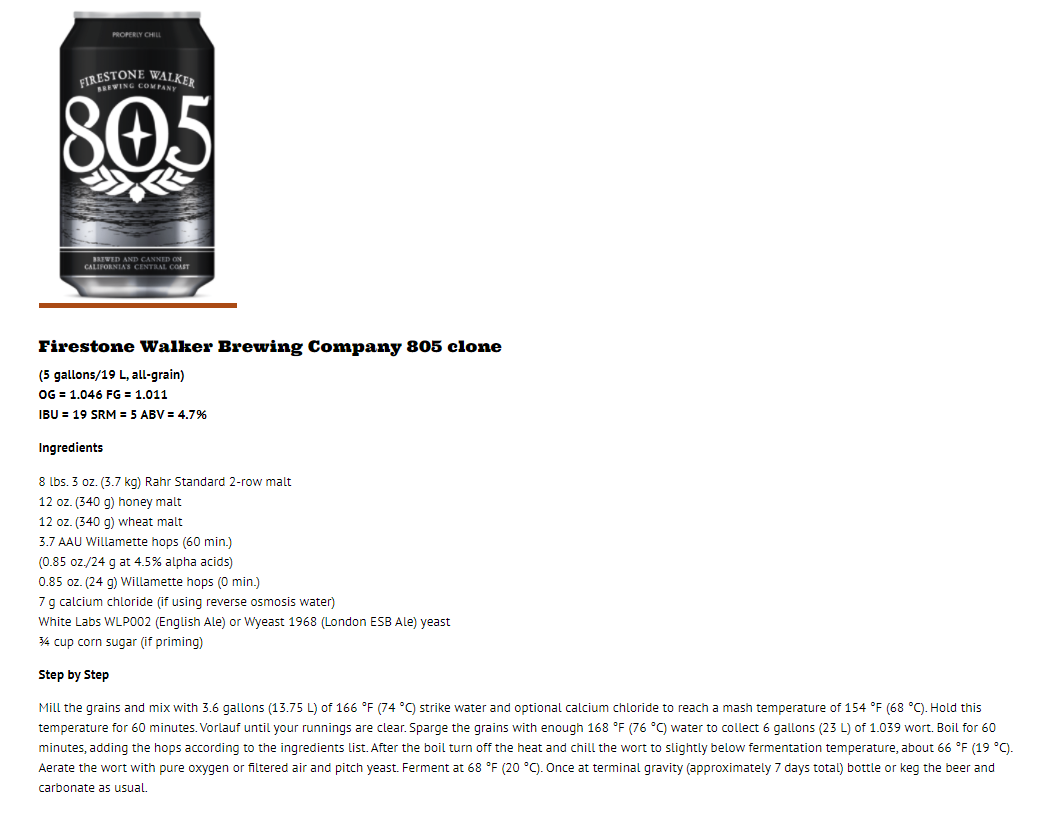Doing a blonde ale here pretty soon. I've never been crazy about blonde ales, but FW's 805 is a perfect example in my opinion. For an easy beer on those days where you just want to have a few, can't beat it. So, I found a clone recipe in BYO that I was going to start with and maybe tweak the hops from there, as the hop character in 805 is the only thing I would increase a smidge (<-- Technical term).
They state in the recipe that they use WLP002 English Ale. However, when I build the recipe in Brewers Friend, as they have it listed, the attenuation of WLP002 is too low. BF calculates FG at 1.016 whereas the recipe shows 1.011. Never used WLP002 - is it really as light of an attenuator as BF shows or is it typically more aggressive?
I'm thinking of using S-04 instead as it gets down to 1.012. Any other English Ale yeast recommendations?
Anyone made something else similar to 805 where the recipe differed from what I have shown?
The other thing I find interesting about the clone recipe is if I enter it exactly as they have laid out, it comes out significantly different - none of the numbers line up as they state. Probably just a result of scaling a recipe down I suppose...

---------------------------------------------------------------------------------------------------------------------------------
Brew Method: All Grain
Style Name: Blonde Ale
Boil Time: 60 min
Batch Size: 18 gallons (ending kettle volume)
Boil Size: 19 gallons
Boil Gravity: 1.044
Efficiency: 75% (ending kettle)
Hop Utilization Multiplier: 0.97
STATS:
Original Gravity: 1.047
Final Gravity: 1.012
ABV (standard): 4.6%
IBU (tinseth): 19.03
SRM (morey): 5.09
Mash pH: 0
FERMENTABLES:
26 lb - Pale 2-Row (85.2%)
2.25 lb - Honey Malt (7.4%)
2.25 lb - Pale Wheat (7.4%)
HOPS:
3.25 oz - Willamette, Type: Pellet, AA: 4.5, Use: Boil for 60 min, IBU: 15.74
3.4 oz - Willamette, Type: Pellet, AA: 4.5, Use: Boil for 5 min, IBU: 3.28
MASH GUIDELINES:
1) Infusion, Temp: 154 F, Time: 60 min, Amount: 10 gal
Starting Mash Thickness: 1.31 qt/lb
YEAST:
Fermentis / Safale - English Ale Yeast S-04
Starter: Yes
Form: Dry
Attenuation (custom): 75%
Flocculation: High
Optimum Temp: 54 - 77 F
Fermentation Temp: 60 F
Pitch Rate: 0.75 (M cells / ml / deg P)
They state in the recipe that they use WLP002 English Ale. However, when I build the recipe in Brewers Friend, as they have it listed, the attenuation of WLP002 is too low. BF calculates FG at 1.016 whereas the recipe shows 1.011. Never used WLP002 - is it really as light of an attenuator as BF shows or is it typically more aggressive?
I'm thinking of using S-04 instead as it gets down to 1.012. Any other English Ale yeast recommendations?
Anyone made something else similar to 805 where the recipe differed from what I have shown?
The other thing I find interesting about the clone recipe is if I enter it exactly as they have laid out, it comes out significantly different - none of the numbers line up as they state. Probably just a result of scaling a recipe down I suppose...

---------------------------------------------------------------------------------------------------------------------------------
Brew Method: All Grain
Style Name: Blonde Ale
Boil Time: 60 min
Batch Size: 18 gallons (ending kettle volume)
Boil Size: 19 gallons
Boil Gravity: 1.044
Efficiency: 75% (ending kettle)
Hop Utilization Multiplier: 0.97
STATS:
Original Gravity: 1.047
Final Gravity: 1.012
ABV (standard): 4.6%
IBU (tinseth): 19.03
SRM (morey): 5.09
Mash pH: 0
FERMENTABLES:
26 lb - Pale 2-Row (85.2%)
2.25 lb - Honey Malt (7.4%)
2.25 lb - Pale Wheat (7.4%)
HOPS:
3.25 oz - Willamette, Type: Pellet, AA: 4.5, Use: Boil for 60 min, IBU: 15.74
3.4 oz - Willamette, Type: Pellet, AA: 4.5, Use: Boil for 5 min, IBU: 3.28
MASH GUIDELINES:
1) Infusion, Temp: 154 F, Time: 60 min, Amount: 10 gal
Starting Mash Thickness: 1.31 qt/lb
YEAST:
Fermentis / Safale - English Ale Yeast S-04
Starter: Yes
Form: Dry
Attenuation (custom): 75%
Flocculation: High
Optimum Temp: 54 - 77 F
Fermentation Temp: 60 F
Pitch Rate: 0.75 (M cells / ml / deg P)


![Craft A Brew - Safale BE-256 Yeast - Fermentis - Belgian Ale Dry Yeast - For Belgian & Strong Ales - Ingredients for Home Brewing - Beer Making Supplies - [3 Pack]](https://m.media-amazon.com/images/I/51bcKEwQmWL._SL500_.jpg)






















































 ... It's on my regular rotation... I just brewed a variation yesterday using sorachi ace for the late additions instead ofCascade... seems promising, so far...
... It's on my regular rotation... I just brewed a variation yesterday using sorachi ace for the late additions instead ofCascade... seems promising, so far...